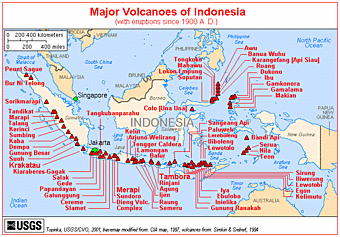Mount Tambora, Sumbawa
 Mount Tambora (or Tomboro) is an active stratovolcano on Sumbawa island, Indonesia. Sumbawa is flanked both to the north and south by oceanic crust, and Tambora was formed by the active subduction zones beneath it. This raised Mount Tambora as high as 4,300 m (14,000 ft),[2] making it one of the tallest peaks in the Indonesian archipelago, and drained off a large magma chamber inside the mountain. It took centuries to refill the magma chamber, its volcanic activity reaching its peak in April 1815.[3]
Mount Tambora (or Tomboro) is an active stratovolcano on Sumbawa island, Indonesia. Sumbawa is flanked both to the north and south by oceanic crust, and Tambora was formed by the active subduction zones beneath it. This raised Mount Tambora as high as 4,300 m (14,000 ft),[2] making it one of the tallest peaks in the Indonesian archipelago, and drained off a large magma chamber inside the mountain. It took centuries to refill the magma chamber, its volcanic activity reaching its peak in April 1815.[3]Tambora erupted in 1815 with a rating of seven on the Volcanic Explosivity Index; the largest eruption since the Lake Taupo eruption in AD 181.[4] The explosion was heard on Sumatra island (more than 2,000 km or 1,200 mi away). Heavy volcanic ash falls were observed as far away as Borneo, Sulawesi, Java and Maluku islands. The death toll was at least 71,000 people, of which 11,000–12,000 were killed directly by the eruption;[4] most authors estimated 92,000 people were killed but this figure is based on an overestimated calculation.[5] The eruption created global climate anomalies; 1816 became known as the Year Without a Summer because of the effect on North American and European weather. Agricultural crops failed and livestock died in much of the Northern Hemisphere, resulting in the worst famine of the 19th century.[4]
During an excavation in 2004, a team of archaeologists discovered cultural remains buried by the 1815 eruption.[6] They were kept intact beneath the 3 m (10 ft) deep pyroclastic deposits. Dubbed the Pompeii of the East, the artifacts were preserved in the positions they had occupied in 1815.
References
^ a b c Tambora. Global Volcanism Program. Smithsonian Institution. Retrieved on 2006-10-07.
^ a b c d e f g h i j k l m n Stothers, Richard B. (1984). "The Great Tambora Eruption in 1815 and Its Aftermath". Science 224 (4654): 1191–1198.
^ a b c Degens, E.T.; Buch, B (1989). "Sedimentological events in Saleh Bay, off Mount Tambora". Netherlands Journal of Sea Research 24 (4): 399–404.
^ a b c d e f g h i j k l m n o Oppenheimer, Clive (2003). "Climatic, environmental and human consequences of the largest known historic eruption: Tambora volcano (Indonesia) 1815". Progress in Physical Geography 27 (2): 230–259.
^ a b c Tanguy, J.-C.; Scarth, A., Ribière, C., Tjetjep, W. S. (1998). "Victims from volcanic eruptions: a revised database". Bulletin of Volcanology 60 (2): 137–144.
^ a b c d e University of Rhode Island (2006-02-27). URI volcanologist discovers lost kingdom of Tambora. Press release. Retrieved on 2006-10-06.
^ a b c Tambora. Global Volcanism Program. Smithsonian Institution. Retrieved on 2006-10-07.
^ a b c d e f g h i j k l m n Stothers, Richard B. (1984). "The Great Tambora Eruption in 1815 and Its Aftermath". Science 224 (4654): 1191–1198.
^ a b c Degens, E.T.; Buch, B (1989). "Sedimentological events in Saleh Bay, off Mount Tambora". Netherlands Journal of Sea Research 24 (4): 399–404.
^ a b c d e f g h i j k l m n o Oppenheimer, Clive (2003). "Climatic, environmental and human consequences of the largest known historic eruption: Tambora volcano (Indonesia) 1815". Progress in Physical Geography 27 (2): 230–259.
^ a b c Tanguy, J.-C.; Scarth, A., Ribière, C., Tjetjep, W. S. (1998). "Victims from volcanic eruptions: a revised database". Bulletin of Volcanology 60 (2): 137–144.
^ a b c d e University of Rhode Island (2006-02-27). URI volcanologist discovers lost kingdom of Tambora. Press release. Retrieved on 2006-10-06.
(From Wikipedia, the free encyclopedia


1 komentar:
The information here is great. I will invite my friends here.
Thanks
Posting Komentar